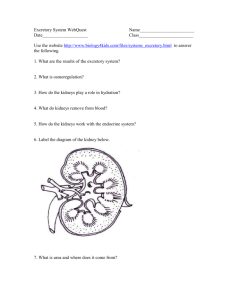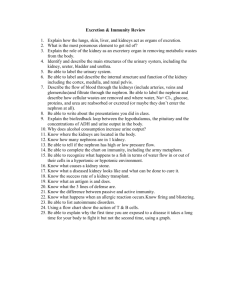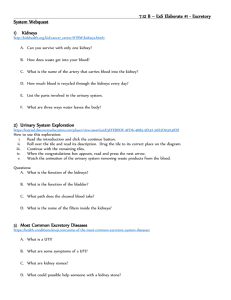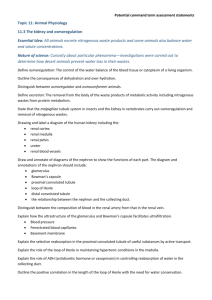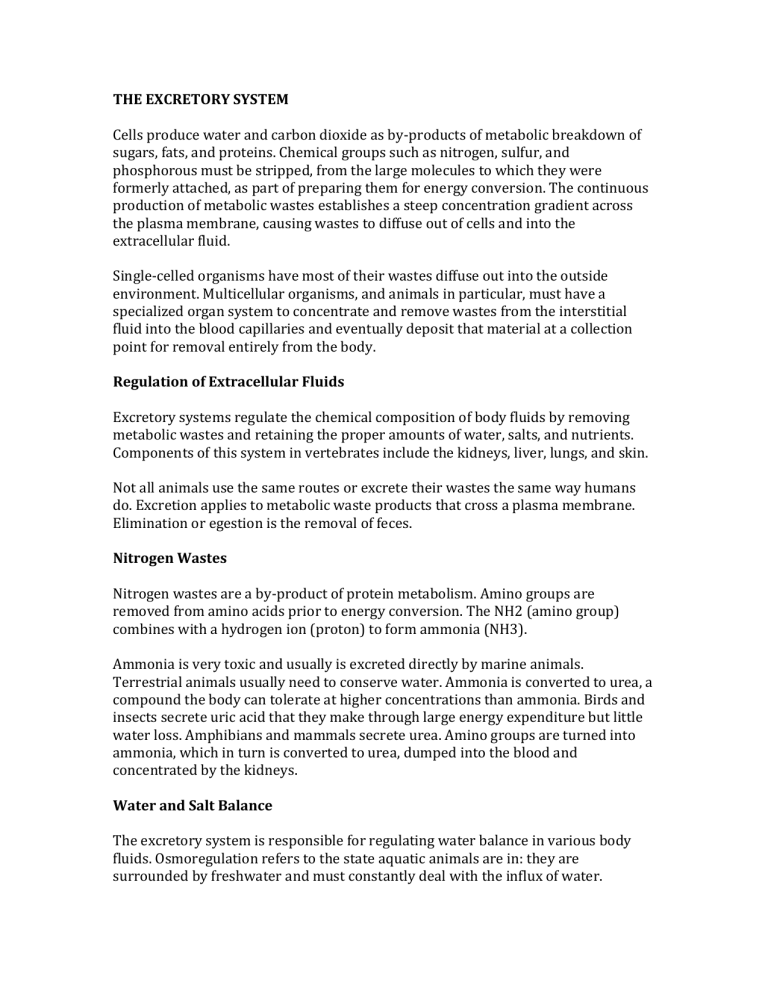
THE EXCRETORY SYSTEM Cells produce water and carbon dioxide as by-products of metabolic breakdown of sugars, fats, and proteins. Chemical groups such as nitrogen, sulfur, and phosphorous must be stripped, from the large molecules to which they were formerly attached, as part of preparing them for energy conversion. The continuous production of metabolic wastes establishes a steep concentration gradient across the plasma membrane, causing wastes to diffuse out of cells and into the extracellular fluid. Single-celled organisms have most of their wastes diffuse out into the outside environment. Multicellular organisms, and animals in particular, must have a specialized organ system to concentrate and remove wastes from the interstitial fluid into the blood capillaries and eventually deposit that material at a collection point for removal entirely from the body. Regulation of Extracellular Fluids Excretory systems regulate the chemical composition of body fluids by removing metabolic wastes and retaining the proper amounts of water, salts, and nutrients. Components of this system in vertebrates include the kidneys, liver, lungs, and skin. Not all animals use the same routes or excrete their wastes the same way humans do. Excretion applies to metabolic waste products that cross a plasma membrane. Elimination or egestion is the removal of feces. Nitrogen Wastes Nitrogen wastes are a by-product of protein metabolism. Amino groups are removed from amino acids prior to energy conversion. The NH2 (amino group) combines with a hydrogen ion (proton) to form ammonia (NH3). Ammonia is very toxic and usually is excreted directly by marine animals. Terrestrial animals usually need to conserve water. Ammonia is converted to urea, a compound the body can tolerate at higher concentrations than ammonia. Birds and insects secrete uric acid that they make through large energy expenditure but little water loss. Amphibians and mammals secrete urea. Amino groups are turned into ammonia, which in turn is converted to urea, dumped into the blood and concentrated by the kidneys. Water and Salt Balance The excretory system is responsible for regulating water balance in various body fluids. Osmoregulation refers to the state aquatic animals are in: they are surrounded by freshwater and must constantly deal with the influx of water. Terrestrial animals use a variety of methods to reduce water loss: living in moist environments, developing impermeable body coverings, production of more concentrated urine. Water loss can be considerable: a person in a 100 degree F temperature loses 1 liter of water per hour. Excretory System Functions 1. Collect water and filter body fluids. 2. Remove and concentrate waste products from body fluids and return other substances to body fluids as necessary for homeostasis. 3. Eliminate excretory products from the body. Excretion in different organisms Single celled organisms, like the protists, such as paramecium, directly diffuse their waste through the cell membrane into the watery environment that they live in. Hydra is a simple, multicellular organism that also directly diffuses the waste through a single layer of cells on the surface of the hydra. Many invertebrates such as earthworms use a nephridium as their excretory organ. As fluid passes down the tubule, solutes are reabsorbed and returned to the body fluids. In insects, body fluids are drawn into the Malphigian tubules by osmosis due to large concentrations of potassium inside the tubule. Body fluids pass back into the body, nitrogenous wastes empty into the insect's gut. Water is reabsorbed and waste is expelled from the insect in the feces. Vertebrates Have Paired Kidneys ALL vertebrates have paired kidneys. Excretion is not the primary function of kidneys. Kidneys regulate body fluid levels as a primary duty, and remove wastes as a secondary one. The Human Excretory System The urinary system is made-up of the kidneys, ureters, bladder, and urethra. The nephron, an evolutionary modification of the nephridium, is the kidney's functional unit. Waste is filtered from the blood and collected as urine in each kidney. Urine leaves the kidneys by ureters, and collects in the bladder. The bladder can distend to store urine that eventually leaves through the urethra. The Nephron The nephron consists of a cup-shaped capsule containing capillaries and the glomerulus, and a long renal tube. Blood flows into the kidney through the renal artery, which branches into capillaries associated with the glomerulus. Arterial pressure causes water and solutes from the blood to filter into the capsule. Fluid flows through the proximal tubule, which include the loop of Henle, and then into the distal tubule. The distal tubule empties into a collecting duct. Fluids and solutes are returned to the capillaries that surround the nephron tubule. The nephron has three functions: 1. Glomerular filtration of water and solutes from the blood. 2. Tubular reabsorption of water and conserved molecules back into the blood. 3. Tubular secretion of ions and other waste products from surrounding capillaries into the distal tubule. Urine Production 1. Filtration in the glomerulus and nephron capsule. 2. Reabsorption in the proximal tubule. 3. Tubular secretion in the Loop of Henle. Kidney Function Kidneys perform a number of homeostatic functions: 1. Maintain volume of extracellular fluid 2. Maintain ionic balance in extracellular fluid 3. Maintain pH and osmotic concentration of the extracellular fluid. 4. Excrete toxic metabolic by-products such as urea, ammonia, and uric acid. Disruption of Kidney Function Infection, environmental toxins such as mercury, and genetic disease can have devastating results by causing disruption of kidney function. Many kidney problems can be treated by dialysis, where a machine acts as a kidney and cleans/filters the blood. Kidney transplants are an alternative to dialysis. Kidney Stones In some cases, excess wastes crystallize as kidney stones. They grow and can become a painful irritant that may require surgery or ultrasound treatments. They can block the release of urine into the ureter.
